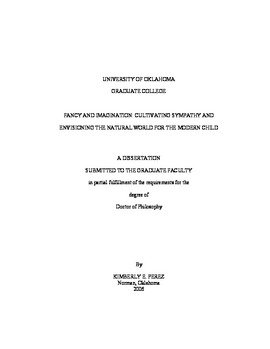| dc.contributor.advisor | Pandora, Katherine, | en_US |
| dc.contributor.author | Perez, Kimberly E. | en_US |
| dc.date.accessioned | 2013-08-16T12:20:24Z | |
| dc.date.available | 2013-08-16T12:20:24Z | |
| dc.date.issued | 2006 | en_US |
| dc.identifier.uri | https://hdl.handle.net/11244/1106 | |
| dc.description.abstract | This dissertation examines the attitudes that scientists, educators, and nature-writers held toward fancy and imagination in nature-study and nature books for children around the turn of the century. In a period where science was professionalizing, scientists were respected for their authority on the natural world, and nature was increasingly valued as a source for rational knowledge, there were those who allowed for a fanciful and imaginative approach toward nature, especially for children. Some educators, nature-writers, and even scientists, argued that fancy and imagination were natural to the developmental process of children and were necessary in order to balance the overly rational view of nature that the modern world provided. This dissertation examines the debate over the roles of fancy and imagination that occurred in nature-study and educational journals. Most science supporters sought to control the direction of nature-study and devalue fancy and imagination in order to promote the values of science. However, amongst this group, there were those who advocated a more moderate approach toward nature-study that allowed for fancy and imagination in moderation. This dissertation explores this position through the work of Liberty Hyde Bailey, Dean of the College of Agriculture at Cornell. Bailey approached nature with a dual outlook; he valued scientific rationality, but in the case of nature-study he argued that "fact is not to be worshipped" because, he advocated, children should be encouraged to develop an artistic outlook on nature. This dissertation also examines the debate over the roles of fancy and imagination in nature books for children. Again, participants were divided; and again, some nature-writers advocated a balance between imaginative, fanciful stories and factual information. This dissertation explores this position through the work Mabel Osgood Wright, an author of nature field guides and narratives for children. Wright incorporated fanciful and imaginative elements into her stories by anthropomorphizing her animal characters, but she also maintained that the information presented was factual. Both Bailey and Wright were motivated in their stance on fancy and imagination to encourage children to form a sympathetic bond with nature so that they may, in turn, respect the natural world. | en_US |
| dc.format.extent | vii, 358 leaves ; | en_US |
| dc.subject | Bailey, L. H. (Liberty Hyde), 1858-1954. | en_US |
| dc.subject | Education, History of. | en_US |
| dc.subject | Education United States Philosophy. | en_US |
| dc.subject | Education United States History. | en_US |
| dc.subject | Nature study History. | en_US |
| dc.subject | History of Science. | en_US |
| dc.subject | Wright, Mabel Osgood, 1859-1934. | en_US |
| dc.subject | Biography. | en_US |
| dc.title | Fancy and imagination: Cultivating sympathy and envisioning the natural world for the modern child. | en_US |
| dc.type | Thesis | en_US |
| dc.thesis.degree | Ph.D. | en_US |
| dc.thesis.degreeDiscipline | Department of History of Science | en_US |
| dc.note | Source: Dissertation Abstracts International, Volume: 67-10, Section: A, page: 3954. | en_US |
| dc.note | Adviser: Katherine Pandora. | en_US |
| ou.identifier | (UMI)AAI3237839 | en_US |
| ou.group | College of Arts and Sciences::Department of History of Science | |
